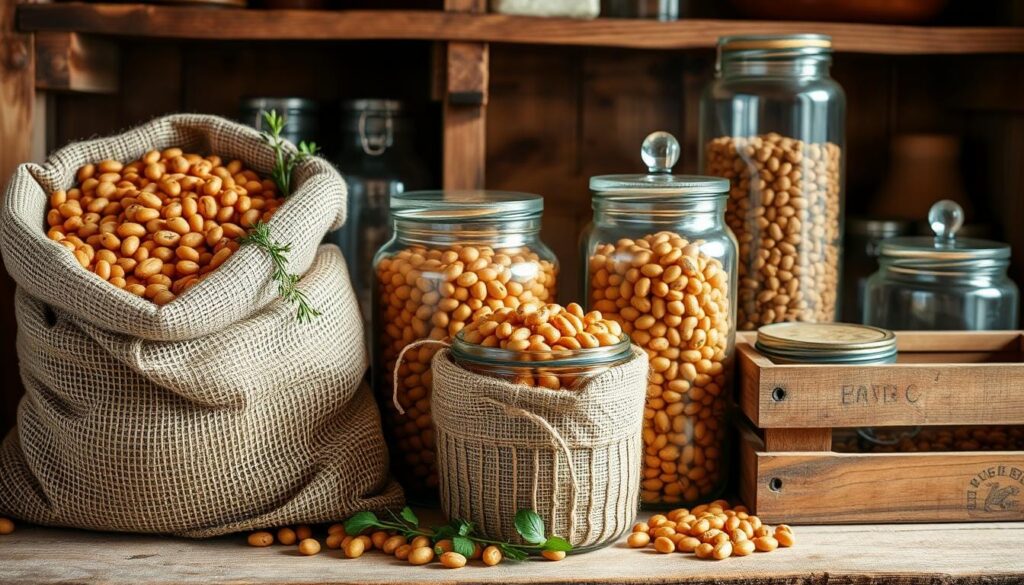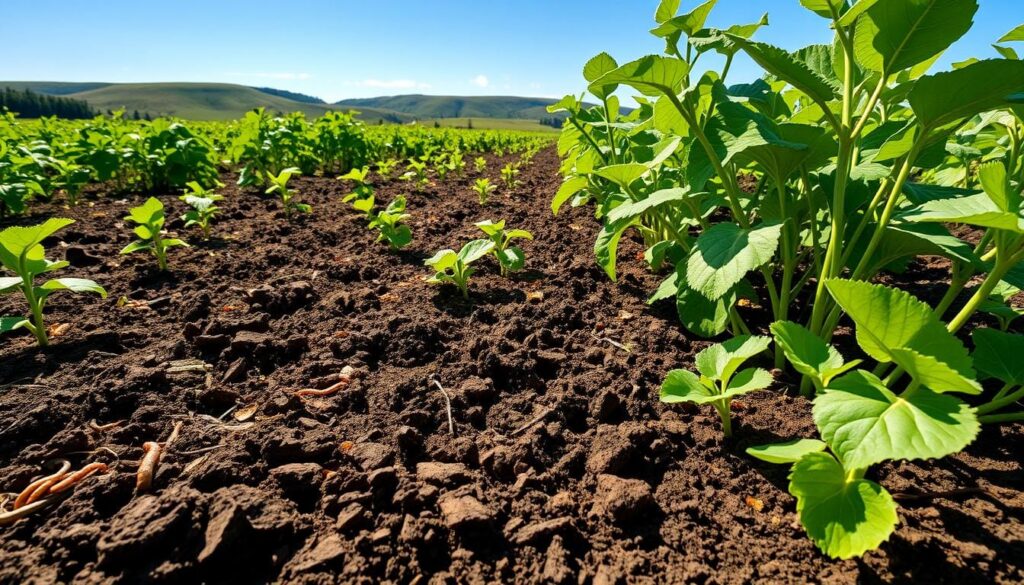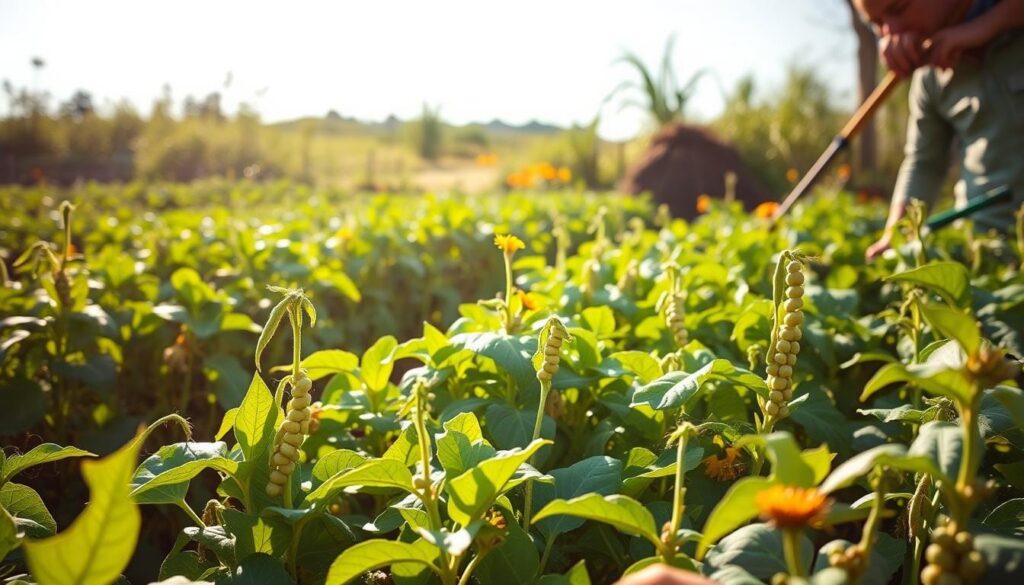The warm summer breeze tells stories of farmers who grew pinto beans. These stories connect us deeply to the land. Learning to harvest pinto beans is a tradition passed down through generations.
Pinto bean harvesting is a mix of patience and precision. These beans come from Mexico and need warm summers and lots of sun. We’ll show you how to harvest pinto beans, making your garden or farm productive and full of nutritious beans.
Whether you’re a farmer or a home gardener, knowing how to harvest pinto beans is key. It can make your crops better and more plentiful. Our guide will teach you the secrets of growing and harvesting pinto beans successfully.
Key Takeaways
- Pinto beans require 90-150 days to mature from planting to harvest
- Full sun exposure of six hours daily is critical for healthy growth
- Ideal soil pH ranges between 6.0 and 7.0 for optimal bean development
- Proper spacing and planting depth significantly impact bean production
- Understanding harvesting signs ensures maximum crop quality
Understanding Pinto Beans
Pinto beans are a key part of American farming. They come from Mexican cuisine and are loved in the U.S. kitchen.
Exploring pinto bean farming shows us how amazing these beans are. We’ll look at their history, types, and health benefits.
Origin and Diversity
Pinto beans started in Mexico and now grow worldwide. They are a favorite in many places. Our farms grow different types:
- Determinate (Bush) Varieties: Compact plants growing around 2 feet tall
- Indeterminate (Pole) Varieties: Climbing plants reaching up to 6 feet
- Prostrate Indeterminate: Spreading varieties with unique growth patterns
Nutritional Powerhouse
Pinto beans are very nutritious. They are full of protein, fiber, and.
| Nutrient | Amount per Cup |
|---|---|
| Protein | 15 grams |
| Fiber | 15.4 grams |
| Iron | 3.6 mg |
| Magnesium | 85 mg |
“Pinto beans are not just a food, they’re a nutritional revolution on your plate.”
Texas buys about 100 million pounds of pinto beans every year. This shows how important they are in our farming world. They grow well in soil with a pH of 6.0 to 7.0. This makes them easy to grow in many places.
Preparing for the Harvest
Growing a successful pinto bean crop needs careful planning. Knowing the right tools and timing is key to a good harvest.
Our journey starts with choosing the right tools and knowing when to harvest. Pinto beans can be picked as green snap beans or as fully mature dry beans.
Essential Tools for Harvesting Pinto Beans
- Hand pruners for small garden plots
- Harvesting baskets or containers
- Gardening gloves
- Drying racks
- Mechanical harvesters for large fields
Soil and Planting Considerations
| Planting Parameter | Recommended Specification |
|---|---|
| Soil pH | 6.0 – 7.0 |
| Planting Depth | 1-2 inches |
| Plant Spacing | 4-6 inches between plants |
| Row Distance | 18-24 inches |
Our pinto bean crop needs the right conditions to grow well. Soil temperature is important, with the best germination at 70ºF to 80ºF. We should keep the soil moist, with about 1 inch of water each week.
“Success in harvesting pinto beans starts long before the actual harvest – it begins with careful preparation and understanding of the crop’s needs.” – Agricultural Expert
Knowing the growth cycle is vital. Pinto beans take 90 to 150 days to mature as dry beans. By watching our crop and preparing well, we can get a great harvest.
Signs That Pinto Beans Are Ready to Harvest
Timing is key in growing pinto beans. Knowing when to pick them is important for quality and yield. We learn when beans are ready by watching for specific signs.
Two main signs tell us when to harvest: pod color and bean texture. These signs help us know the best time to pick our pinto beans.
Color Changes in Pods
Pinto bean pods change color as they mature. When they’re ready, they turn from green to tan or grey. This color change means the beans are dry enough to harvest.
- Fresh pods: Green with red stripes and spots
- Mature pods: Tan or grey appearance
- Completely dry pods: Crisp and brittle texture
Texture of the Beans
The feel of pinto beans tells us if they’re ready. A dry bean feels crisp and has no moisture left.
| Bean Stage | Texture Characteristics | Harvest Recommendation |
|---|---|---|
| Immature | Soft, green pods | Not ready for harvest |
| Mature | Firm, tan-colored pods | Ready for dry bean harvest |
| Fully Dried | Crisp, no moisture | Perfect for storage |
“In pinto bean agriculture, patience determines quality.” – Agricultural Harvest Expert
Success in growing pinto beans comes from noticing these small but important signs. By watching pod color and bean texture, we pick at the perfect time. This ensures our beans are full of flavor and nutrients.
The Best Methods for Harvesting
Pinto bean harvest season needs careful planning. The right harvesting method can greatly improve your bean crop’s quality and amount. Our guide will show you the best pinto bean farming techniques for harvesting.
Farmers use two main ways to gather pinto beans: hand harvesting and mechanical harvesting. Each method has its own benefits, depending on your farm’s size.
Hand Harvesting Techniques
Small-scale farmers often choose hand harvesting for its precision. Here are the key steps for successful hand harvesting:
- Wait until pods turn yellow to tan
- Gently pull beans from the vine
- Ensure pods are completely dry
- Carefully remove beans to prevent damage
“Patience is key in hand harvesting. Take time to collect each pod carefully.” – Experienced Bean Farmer
Mechanical Harvesting Methods
Large farms use mechanical harvesters for better efficiency during pinto bean harvest season. These machines can quickly process fields while keeping damage low.
- Use combine harvesters designed for bean crops
- Adjust machine settings to prevent bean breakage
- Harvest when moisture content is low
- Inspect equipment before and after use
Choosing between hand and mechanical harvesting depends on your farm’s size, budget, and specific pinto bean farming techniques.
Post-Harvest Processing
After we finish harvesting our pinto beans, the real work starts. We must keep our beans in top shape. This means we need to process them right.
Harvesting pinto beans requires careful steps. These steps help protect our beans from damage. They also keep their quality high.
Cleaning Our Beans
Cleaning pinto beans is key. We must get rid of:
- Debris and dirt particles
- Damaged or broken bean pods
- Foreign materials collected during harvesting
Effective Drying Techniques
Drying is vital for keeping beans fresh. We use a few methods:
- Natural Air-Drying: Spread beans in thin layers on clean surfaces
- Mechanical Drying: Using special equipment
- Hanging entire plants in dry, well-ventilated areas
“Proper drying can make the difference between a successful harvest and significant crop loss.”
If late rains hit during harvesting, we pull the plants. Then, we hang them to dry. This method helps dry the beans further.
We aim for a moisture level of 15% to 18%. This helps avoid damage during processing.
Storing Pinto Beans
Keeping our dried pinto beans fresh is key. After we harvest, we want to keep them good for as long as we can. This way, they stay nutritious and tasty.

Our beans need the right storage to last longer. The right conditions help keep them fresh and full of nutrients. This way, we can enjoy our harvest for a long time.
Optimal Storage Conditions
Storing pinto beans right involves a few important steps:
- Keep moisture levels below 16%
- Store them in a cool, dry place
- Keep them away from sunlight and heat
- Don’t let them get wet or humid
Containers for Long-Term Storage
Choosing the right container is key for keeping our beans fresh. Each container has its own benefits:
| Container Type | Shelf Life | Benefits |
|---|---|---|
| Food-Grade Polyethylene Bags | 1-2 years | Affordable, lightweight |
| Mylar Bags with Oxygen Absorbers | 10+ years | Extended preservation, minimal nutrient loss |
| #10 Sealed Cans | 10+ years | Maximum protection, ideal for emergency storage |
Pro tip: The USDA says to eat dry beans within 1-2 years for the best taste.
“Proper storage turns our harvest into a lasting food source.” – Agricultural Storage Expert
By using these storage tips, we can keep our pinto beans fresh for months or years. This way, we can enjoy them for a long time.
Troubleshooting Common Issues
Growing a successful pinto bean crop needs careful attention and proactive management. Even experienced farmers face challenges during harvesting. These can affect yield and quality.
Understanding Pest Infestations
Pests are a big risk to our pinto bean crop. We must watch for early signs of infestations. Common pests include:
- Mexican bean beetles
- Aphids
- Leafhoppers
- Spider mites
- Flea beetles
Effective Pest Management Strategies
To protect our crops, we need integrated pest management. Early detection and targeted actions can reduce damage.
| Pest | Damage | Control Method |
|---|---|---|
| Mexican Bean Beetle | High leaf destruction | Hand removal, neem oil |
| Aphids | Sap sucking, virus transmission | Insecticidal soap, beneficial insects |
| Flea Beetles | Leaf holes, seedling damage | Row covers, crop rotation |
Weather Impact on Harvest
Weather greatly affects our pinto bean crop’s success. Key factors include:
- Temperature: Best between 60-85°F
- Moisture: 1-2 inches of water weekly
- Sunlight: 6-8 hours daily
“Successful farming is about adapting to nature’s unpredictability.” – Sustainable Agriculture Expert
By understanding challenges and using strategic interventions, we can protect our pinto bean crop. This ensures a good harvest.
Maintaining Soil Health for Future Harvests
Soil health is key for successful pinto bean harvests. We focus on nutrient management and crop rotation in our pinto bean horticulture.

Knowing your soil is vital for growing beans well. Our soil management covers several important points:
- Maintaining optimal soil pH between 6.0 and 7.5
- Ensuring proper nutrient balance
- Implementing effective crop rotation techniques
Nutrient Management Strategies
Pinto beans need specific nutrients. They fix nitrogen naturally, which cuts down on fertilizers. When more nutrients are needed, we suggest:
| Nutrient Type | Recommended Ratio | Application Timing |
|---|---|---|
| Low-Nitrogen Fertilizer | 5-10-10 | Planting and Mid-Season |
| Phosphorus | 3-5-5 | Early Growth Stage |
Crop Rotation Practices
Rotating pinto beans with other crops stops soil depletion and disease. Strategic crop rotation breaks pest cycles and maintains soil fertility.
“Healthy soil is the foundation of successful agriculture” – Agricultural Experts
By using these soil health practices, we make sure our pinto bean crops keep growing well. This supports sustainable and productive pinto bean agriculture for the future.
Incorporating Pinto Beans in Our Diet
After we carefully grow our pinto beans, it’s time to make them into tasty dishes. The pinto bean harvest season is a chance to enjoy their rich flavors and health benefits.
Pinto beans are full of nutrients. They have about 15.1 grams of protein per cooked cup and 15.4 grams of dietary fiber. These beans are great for those who want to eat healthier.
Delicious Recipes to Try
Our pinto bean farming gives us ingredients for many dishes. Here are some tasty recipe ideas:
- Classic Mexican Refried Beans – A traditional staple in southwestern cooking
- Hearty Pinto Bean Chili
- Rustic Bean and Rice Casserole
- Spicy Southwest Bean Salad
Cooking Tips to Enhance Flavor
Get the most out of your pinto beans with these cooking tips:
- Soak beans overnight to reduce cooking time
- Add salt after cooking to prevent tough beans
- Experiment with spices like cumin and paprika
- Use slow cooking methods for deeper flavors
“Pinto beans are not just food; they’re a celebration of our agricultural heritage and culinary creativity.”
By adding these nutritious beans to our meals, we enjoy tasty food and support sustainable farming. Pinto beans are low in sugar and high in protein, making them a superfood to celebrate.
Sustainability Practices in Bean Harvesting
Sustainable agriculture is key to responsible pinto bean harvesting. We aim to lessen environmental harm while boosting crop yield. Eco-friendly methods help us care for our land and enhance DIY gardening practices.

Reducing Waste in Pinto Bean Production
Smart farming is the first step to cut waste. We use careful planning and new harvesting methods to reduce losses. Our main objectives are:
- Maximizing crop utilization
- Implementing precision harvesting methods
- Recycling plant materials
Eco-Friendly Farming Techniques
Sustainable pinto bean harvesting needs a complete strategy. We’ve found several methods that boost crop health and protect the environment:
| Technique | Environmental Benefit |
|---|---|
| Companion Planting | Reduces pest pressure naturally |
| Nitrogen Fixing | Improves soil health without synthetic fertilizers |
| Crop Rotation | Breaks pest and disease cycles |
*”Sustainable farming is not just about harvesting pinto beans, but nurturing the entire ecosystem.”*
Our studies reveal that upright pinto bean varieties can cut harvesting time by 40% and lower crop losses. The Long’s Peak Upright Pinto variety shows how smart breeding can make farming more sustainable.
By using these methods, we help ensure a greener future for pinto bean harvesting. We protect our crops and the environment.
The Role of Pinto Beans in American Agriculture
Pinto beans are a key part of American farming. They show the country’s economic power and cultural roots. These beans are not just a crop; they symbolize progress and healthy eating.
Our work with dried pinto beans is vital in the US. They are grown in 19 states, making them a big deal in farming. In fact, pinto beans make up over a third of all dry beans eaten in the US.
Economic Significance
Pinto beans have a big economic impact. Here are some key facts:
- On average, each American eats about 6.5 lbs of pinto beans a year.
- The top bean-producing states are Nebraska, Idaho, and Michigan.
- The US produces around 1.0 million metric tons of pinto beans every year.
Cultural Significance
Pinto beans also hold a special place in culture. Mexican Americans and Hispanics love them. They use these beans in their food and family traditions.
“Beans are recognized as a nutrient-dense food source, highlighting their vital role in protein intake.”
One cup of pinto beans is packed with nutrients. It gives you:
- 74% of your daily folic acid
- 30% of vitamin B6
- 11% of iron
Our journey with pinto beans is ongoing. It shows the growth, sustainability, and cultural value of American farming.
How to Prepare for Next Year’s Harvest

As we finish our current pinto bean crop harvest, it’s time to plan for next year. Preparing for the next growing season is key. We need to think ahead and use smart farming practices.
Selecting the Right Seeds
Choosing the right seeds is vital for a healthy pinto bean crop. We look at several important factors when picking seeds:
- Disease resistance
- Yield capacity
- How well they adapt to our local climate
- How long the seeds stay good when stored
Our studies show that bean seeds can stay good for at least 3 years. This is if they are kept cool and dry.
Creating an Effective Planting Schedule
Creating a good planting schedule is key to success. Here are some important tips:
- Plant beans when the soil is over 50°F
- Plant every 2-3 weeks to keep a steady supply
- Stop planting 2-3 months before the first frost
“Successful bean farming is about timing, preparation, and understanding your local agricultural environment.”
By carefully choosing seeds and planning our planting, we’re ready for a bountiful harvest next year.
Community Resources for Bean Farmers
Exploring pinto bean agriculture can be tough, but we’re not alone. Finding the right community resources can change our experience. It offers valuable insights and support.
Local Agricultural Extensions
Our local agricultural extensions are full of knowledge for pinto bean farmers. They give us region-specific advice that can boost our harvests. They offer:
- Tailored soil analysis recommendations
- Crop management strategies
- Pest control insights
- Weather-related planting advice
Online Forums and Support Groups
Digital platforms have changed how we share knowledge in pinto bean agriculture. Online communities connect farmers worldwide. We can share experiences and solve problems together.
| Resource Type | Benefits |
|---|---|
| Facebook Groups | Real-time advice and community support |
| Agricultural Forums | In-depth technical discussions |
| Reddit Communities | Diverse perspectives from global farmers |
“Knowledge shared is knowledge multiplied” – Agricultural Community Wisdom
Using these resources helps us improve our pinto bean horticulture. It leads to more successful and sustainable harvests.
Conclusion: Enjoying Our Pinto Bean Harvest
Our journey through the pinto bean harvest season has been amazing. We’ve learned how to grow pinto beans from seed to table. From planting to harvesting, we’ve seen every step of growing these nutritious beans.
As farmers and gardeners, we’re proud of our work. We focus on soil health, water, and keeping pests away. Growing pinto beans is more than just food. It’s a tradition that connects us to farmers of the past.
Celebrating Our Success
Every bean we pick shows our hard work and dedication. Whether for ourselves or others, our harvest is a sign of our hard work. The beans we grow are full of protein, showing our skill and patience over 100 to 120 days.
Keeping the Tradition Alive
By learning these farming techniques, we’re not just growing food. We’re sharing knowledge for the future. Our work keeps the tradition of growing pinto beans alive in American farms.

